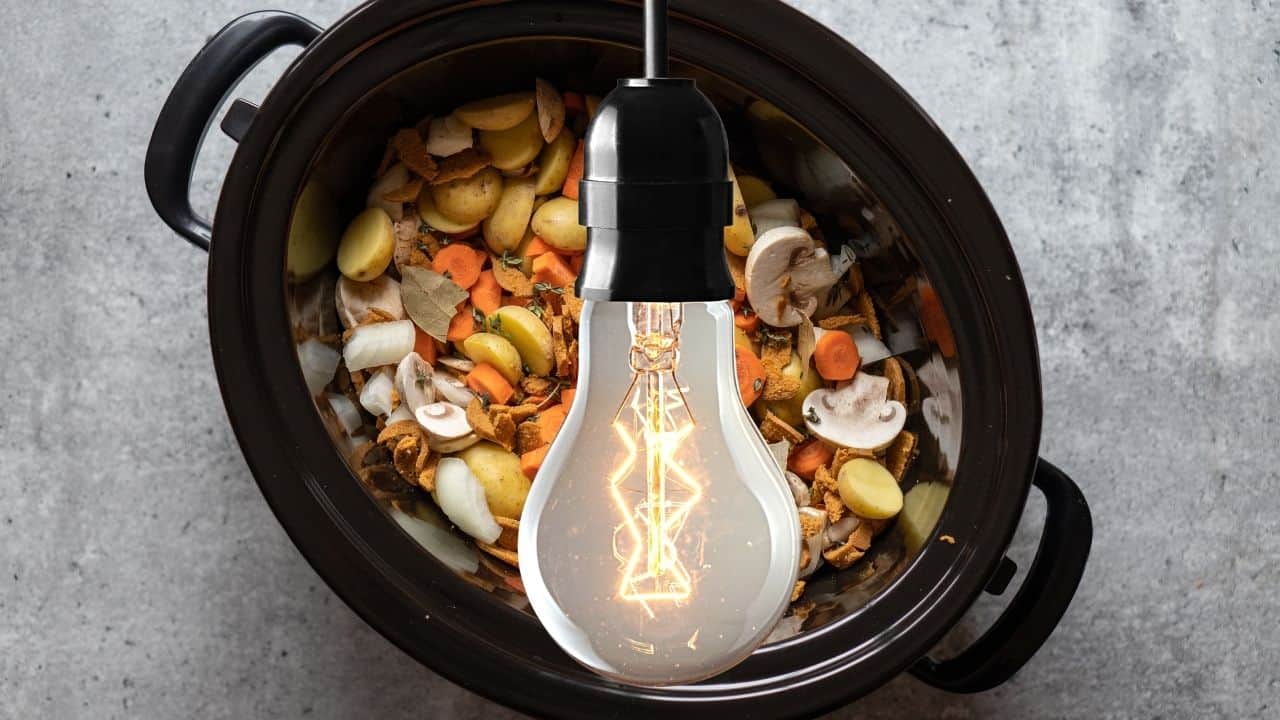Stew on This: Slow Cooker Energy Consumption Revealed!
Hold on, are you telling me a slow cooker is as energy-friendly as a light bulb? You bet! Imagine dishing up delicious meals using only 70 to 150 watts! That’s right, in 8 hours, a modern slow cooker uses just 0.7 to 1.3 kWh of electricity.
In this article, we’ll take a closer look at how much this actually costs to run a slow cooker and compare it with other appliances you have in your kitchen. Trust me; it’s going to be interesting!
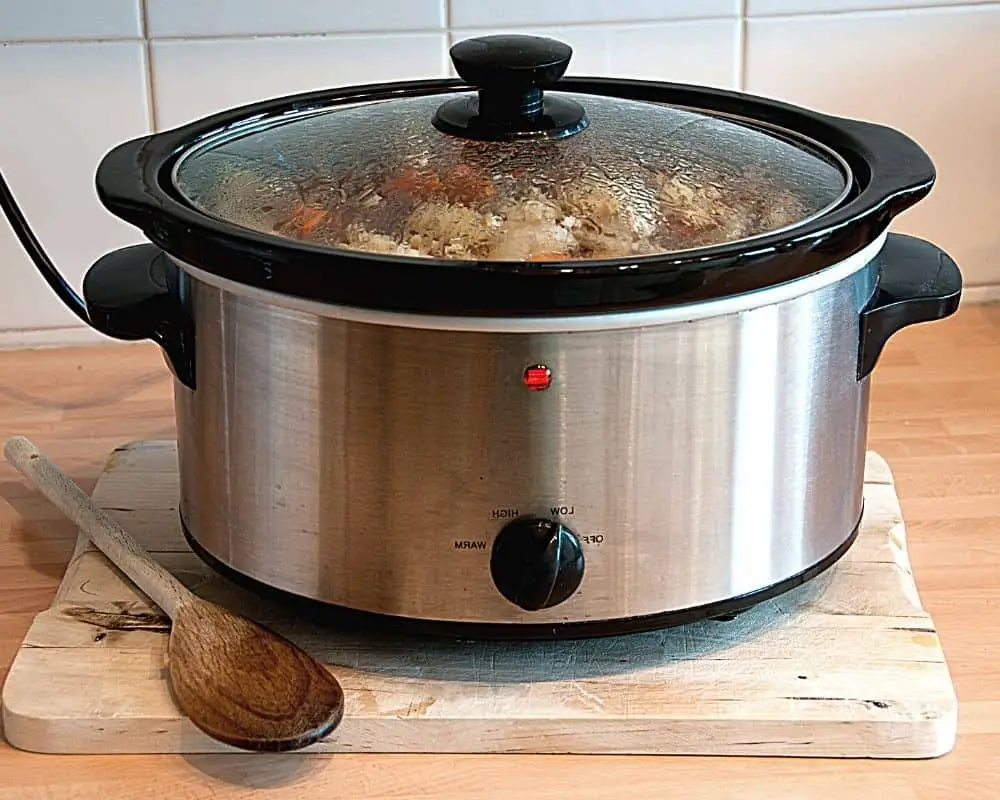
Slow cookers, or crockpots as they’re often called, are pretty awesome. They let you whip up everything from succulent meats to tasty stews, all while being energy savers.
So if you’re on a mission to reduce your kitchen’s electricity usage without skimping on the quality of your meals, you’re in the right place. Read on to learn more about the energy efficiency and cost of operating this kitchen superstar!
Check Out: This Must Be The Most Energy Efficient Slow Cooker!
Short on time? Skip the reading and catch our video below: “How Much Does a Slow Cooker Cost to Run?
Breakdown of a Slow Cooker’s Energy Consumption
The energy consumption of your slow cooker varies depending on its make, model, size, cooking temperature, and cooking time.
Most cookers have three temperature ranges:
- Low: 190°F (87°C)
- High: 300°F (149°C)
- Warm: 140°F (74°C)
All slow cookers have a wattage rating, which indicates the amount of electricity it requires. Check the user manual or the label at the bottom of your slow cooker to find the watt rating.
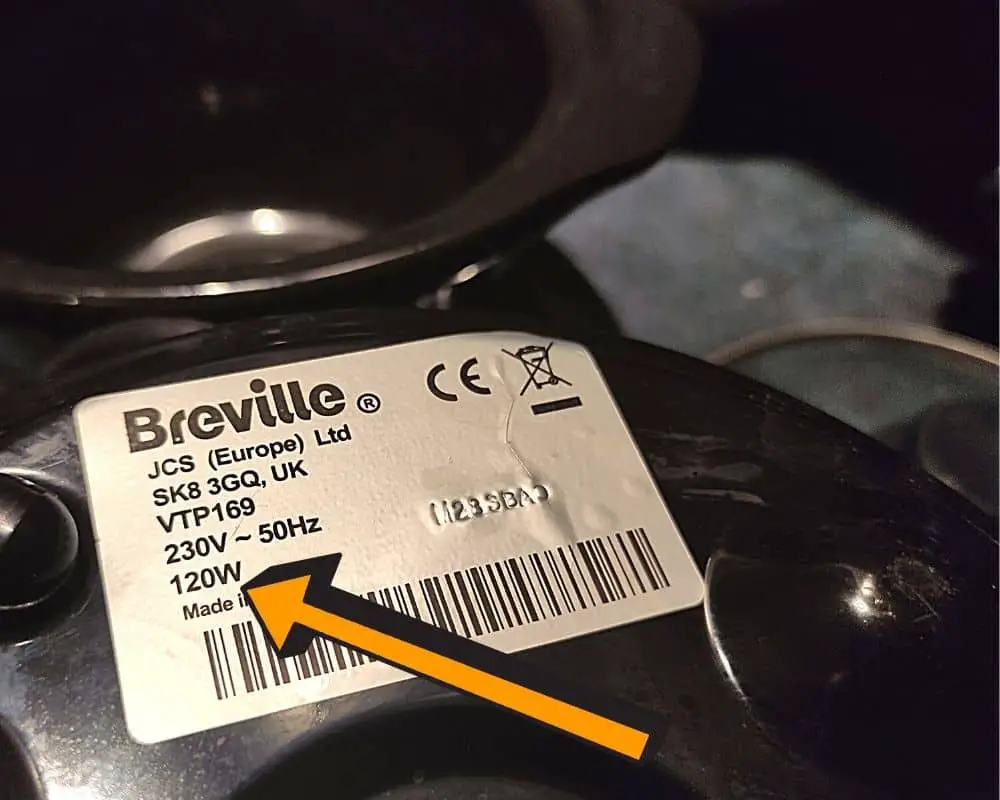
For example, a 1.5-quart slow cooker is rated at around 120 W (0.12 kW). A lower watt rating means less electricity consumption.
One-Hour Electricity Usage

A slow cooker typically uses between 75 to 150 watts per hour on the low setting and 150 to 250 watts on the high setting.
Here’s a breakdown of electricity consumption for a slow cooker on a low setting with a 100-watt rating:
| Country | kW | Price/kWh | Total cost/hr |
|---|---|---|---|
| U.S. | 0.1 | 23 cents | $0.023 |
| U.K. | 0.1 | 34p (34 pence) | £0.034 |
24-Hour Electricity Usage
Slow cookers can safely operate for extended periods due to their simple design and low cooking temperature. Below is the slow cooker energy consumption for a 24-hour operation using a 100-watt rating on a low setting:
| Country | kW | Price/kWh | Total cost/24hr |
|---|---|---|---|
| U.S. | 0.1 | 23 cents | $0.55 |
| U.K. | 0.1 | 34p (34 cents) | £0.82 |
Check out also how I cooked garlic in a slow cooker for 40 days!
What Affects a Slow Cooker’s Energy Consumption?
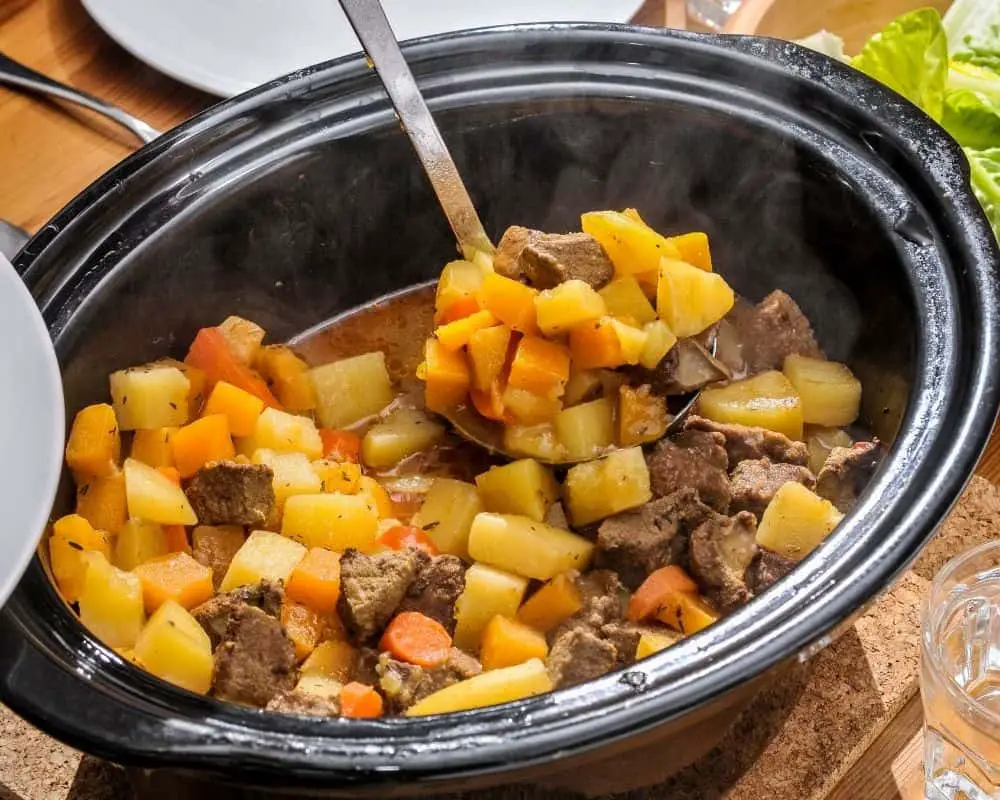
Several factors affect a slow cooker’s energy consumption:
- Size of a Slow Cooker: Larger cookers generally consume more electricity due to bigger heating elements.
- Cooking Temperature: Different recipes require varying cooking temperatures. Higher temperatures consume more electricity.
- Cooking Time: Longer cooking sessions result in higher electricity consumption.
Are Slow Cookers Energy-Efficient?
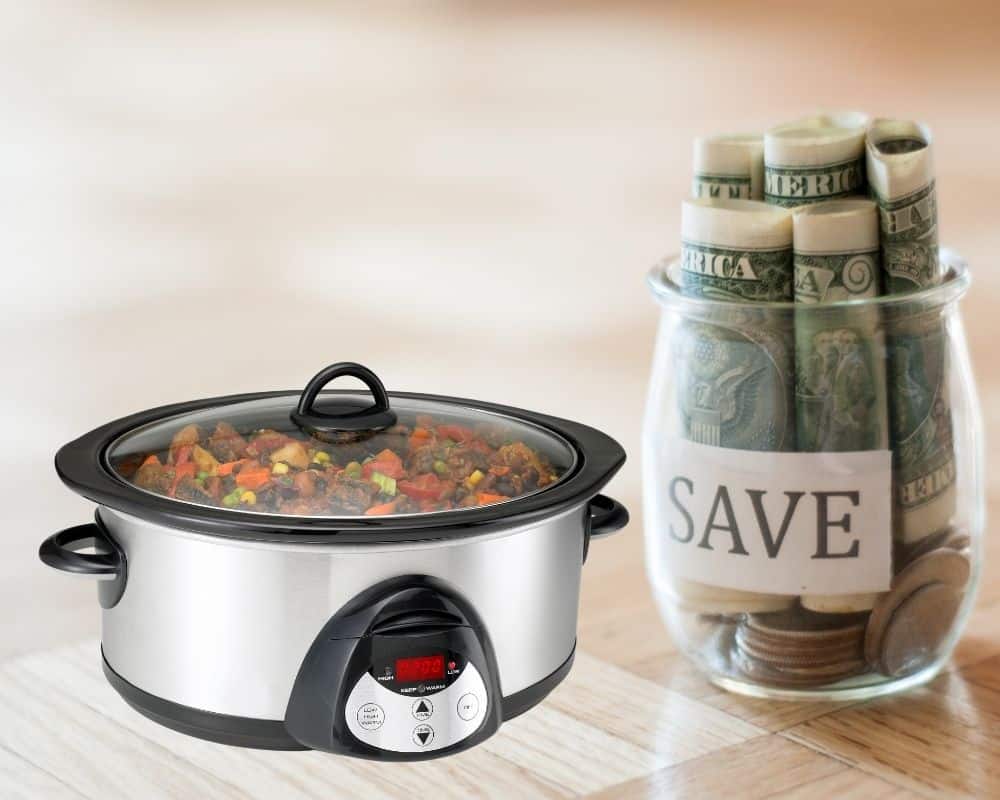
Slow cookers are remarkably energy-efficient thanks to their unique design and low cooking temperature. They use significantly less electricity compared to ovens and stoves, making them an economical choice.
How Can Slow Cookers Cook So Energy Efficiently?

Understanding how slow cookers work helps to comprehend their energy efficiency. A slow cooker primarily consists of three components:
- Ceramic Pot: Often made of porcelain or stoneware, it sits inside the metal heating element.
- Heating Element: A low-wattage electric coil, usually situated at the base inside the metal casing. Some models have heating elements wrapping around the sides of the ceramic bowl.
- Clear Glass Lid: Fits tightly on the ceramic pot, trapping steam and creating a vacuum seal.
The insulation layers around the heating element preserve the heat inside the slow cooker, ensuring even cooking. The ceramic pot retains heat effectively, transmitting it gently and steadily, while the glass lid locks in moisture. Additionally, temperature sensors monitor and maintain a stable cooking temperature.
Slow Cooker vs. Oven Energy Consumption and Running Cost
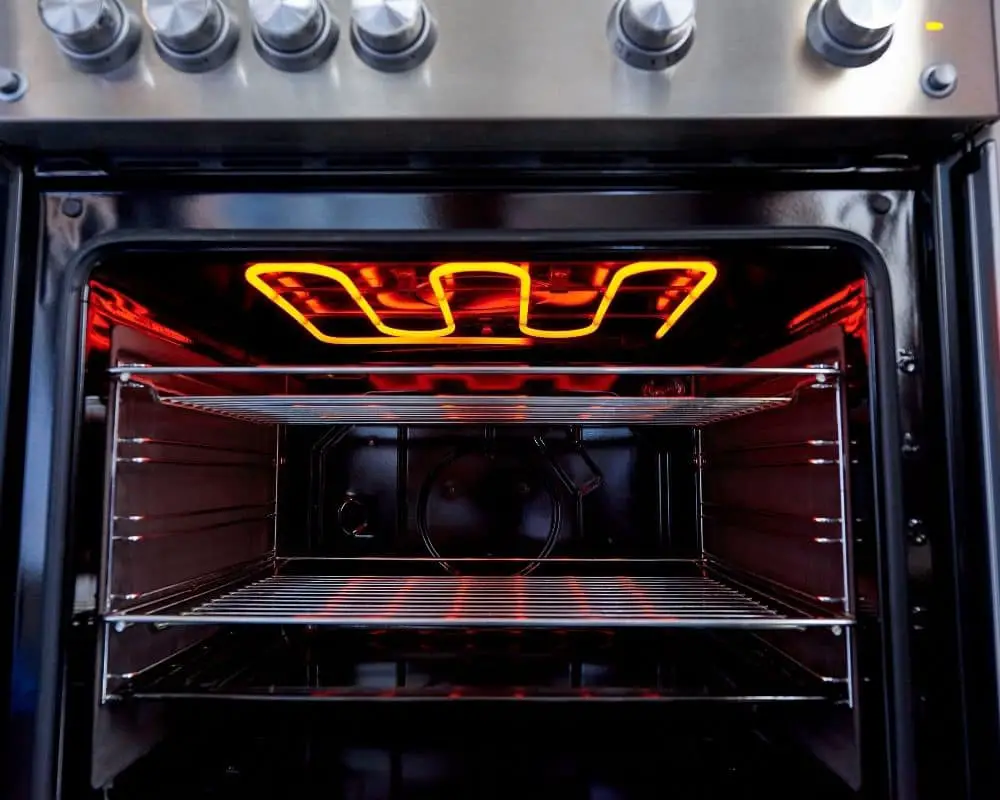
Slow cookers use considerably less electricity than most kitchen appliances. Below is a comparison table for the energy consumption of common kitchen appliances:
Please note that this table below serves illustrative purposes, as you typically won’t be using an oven or microwave for 24 hours non-stop.
| Appliance | Average kWh | Total cost/24hr (USD) | Total cost/24hr (GBP) |
|---|---|---|---|
| Slow cooker | 0.075-0.21 | 0.14-0.46 | 0.31-0.86 |
| Electric oven | 2-5 | 11.04-27.6 | 16.32-41.4 |
| Electric cooker | 1.2-3 | 6.62-16.56 | 9.79-24.48 |
| Microwave | 1.2 | 6.62 | 9.79 |
| Blender | 0.4 | 2.21 | 3.26 |
Explanation:
For the Slow Cooker:
- In the US: 0.075 kWh * 24 hours * 23 cents = $0.14 to 0.21 kWh * 24 hours * 23 cents = $0.46
- In the UK: 0.075 kWh * 24 hours * 34p = £0.31 to 0.21 kWh * 24 hours * 34p = £0.86
For the Electric Oven:
- In the US: 2 kWh * 24 hours * 23 cents = $11.04 to 5 kWh * 24 hours * 23 cents = $27.6
- In the UK: 2 kWh * 24 hours * 34p = £16.32 to 5 kWh * 24 hours * 34p = £41.4
For the Electric Cooker:
- In the US: 1.2 kWh * 24 hours * 23 cents = $6.62 to 3 kWh * 24 hours * 23 cents = $16.56
- In the UK: 1.2 kWh * 24 hours * 34p = £9.79 to 3 kWh * 24 hours * 34p = £24.48
For the Microwave:
- In the US: 1.2 kWh * 24 hours * 23 cents = $6.62
- In the UK: 1.2 kWh * 24 hours * 34p = £9.79
For the Blender:
- In the US: 0.4 kWh * 24 hours * 23 cents = $2.21
- In the UK: 0.4 kWh * 24 hours * 34p = £3.26
Note: The figures have been rounded to two decimal places for clarity. The rates used are 23 cents per kWh in the U.S. and 34p (or £0.34) per kWh in the U.K., as per the updated rates for the year 2023.
Safety and Maintenance of Slow Cookers
Read more about the safety of leaving the slow cooker on overnight.
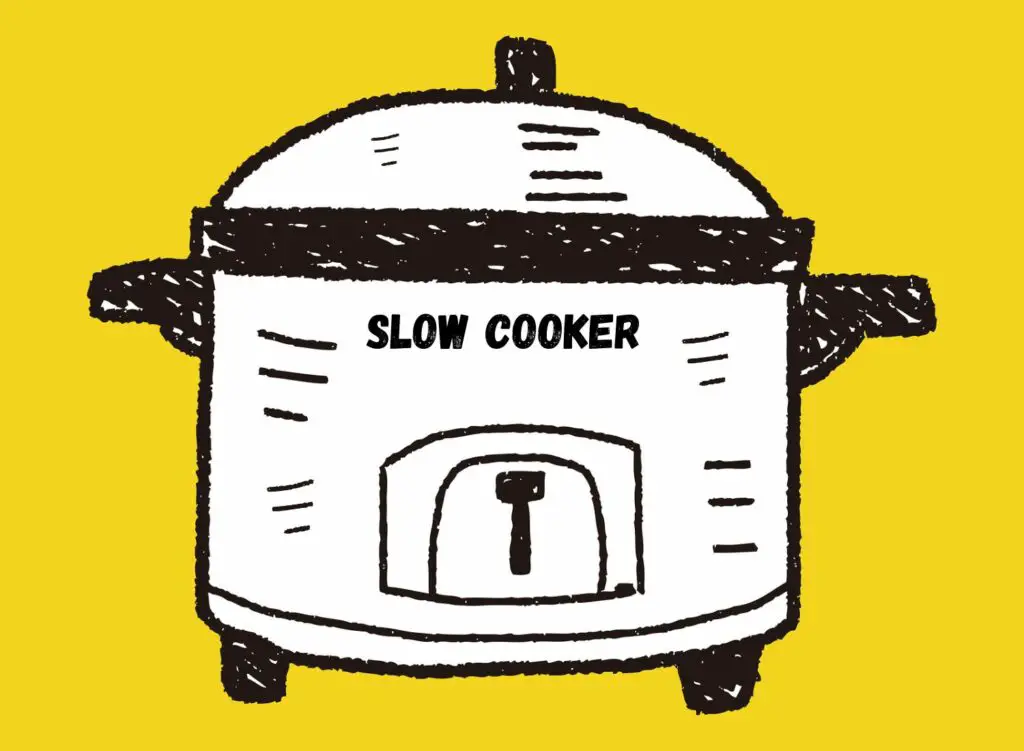
As with any appliance, proper use and maintenance are vital to ensure your slow cooker’s longevity and safe operation. Here are some tips to keep your slow cooker running smoothly:
- Don’t Overfill: Avoid filling the slow cooker more than two-thirds full to prevent spillage and uneven cooking.
- Use the Right Lid: Always use the lid that comes with your slow cooker to ensure a proper fit.
- Regular Cleaning: After each use, clean the ceramic pot and lid with warm, soapy water. Avoid using abrasive cleaners that could scratch the surface.
- Check for Cracks: Before each use, check the ceramic pot for any cracks or chips. A damaged pot should be replaced.
- Safe Placement: Place your slow cooker on a flat surface and away from walls or any flammable materials to prevent overheating and fire hazards.
- Follow Recipes: Follow slow cooker recipes closely, especially regarding cooking times and liquid levels, to ensure food is cooked thoroughly and safely.
Slow Cooker vs Other Appliances – Summary
Slow cookers are a versatile and economical option for preparing various meals. They use significantly less electricity than other kitchen appliances and offer a convenient set-it-and-forget-it cooking method that can help you make healthier and tastier meals with minimal effort.
Whether you’re making a pot roast, soup, or cake, slow cookers provide an energy-efficient alternative to using your oven or stovetop. With the updated electricity rates in 2023, you can better understand how much using a slow cooker can affect your electricity bill and adjust your cooking habits accordingly.
Benefits Of a Slow Cooker

The Crocpots’ popularity really took off in the early 1970s; however, slow cookers are making a comeback to most modern kitchens due to their ease of use and the wide variety of recipes available.
Here are a few benefits why you should consider getting a slow cooker:
- Set and forget. These cookers give you the freedom and flexibility we all crave in the kitchen. Just pop your food inside, set the timer, and enjoy your food later.
- Energy-efficient. Let’s face it; slow cookers are at the top of the game regarding power savings when compared to other cooking appliances.
- Preserves the flavor. Imagine having your meats or perfectly seasoned beef stew simmering for hours with all the delicious flavors locked in. Slow cookers will give you exceptional food taste and flavor by allowing the ingredients to blend together at a low temperature and become better balanced.
- Easy to clean. No more hassle of cleaning dozens of pots, plates, and other utensils. This one-pot cooking technique makes cleaning much more manageable. You can even go a step further and use Slow Cooker Liners so you don’t even need to wash the pot, simply remove the bag and throw it away.
- Healthy and affordable cooking. Using the one-pot method makes cooking easier and faster. This ease of cooking promotes home cooking with such a wide variety of healthy recipes to choose from, which are nutritious and affordable, keeping your grocery bill under control.
- Helps tenderize hard foods. Some types of foods like lentils, grains, or less-expensive cuts of meat are tough and naturally complex and don’t cook as fast. Using other cooking methods to get the same tender and delicate result could significantly increase your energy bills.
A slow cooker is an excellent energy-efficient addition to your kitchen and will save you money on your electricity bill and make your life easier. This simple appliance will not only reduce your electricity cost but help you eat tastier and healthier food.
Additionally, the extended cooking period will kill germs and help to bring out the flavor in foods.
And because you are saving time and money, it does not mean that you are sacrificing the flavor.
Why don’t you give it a try today and make one of these classic and flavorsome Slow Cooker Split Pea Soup Recipes With Ham And Potatoes?
Conclusion!
Stay savvy in the kitchen with your slow cooker, and relish the flavors it brings to your table.
So, is a slow cooker as energy-efficient as a light bulb? Quite so! It uses a small amount of electricity, comparable to a light bulb, and significantly less than most kitchen appliances like ovens or electric cookers.
With the 2023 electricity rates in mind, using a slow cooker is not just a culinary choice but also an economic one. Its efficiency, coupled with the ability to tenderize tough cuts and create deeply flavored dishes, makes it an invaluable addition to your kitchen. Keep your electricity bills in check, your kitchen cooler, and your meals delightful with this handy appliance.
